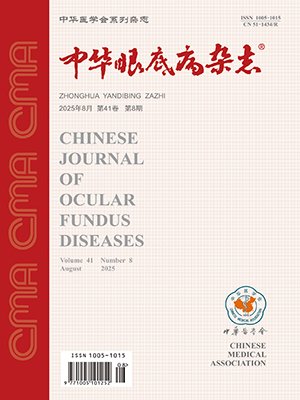| 1. |
黎晓新. 中国早产儿视网膜病变筛查指南(2014年)[J]. 中华眼科杂志, 2014, 50(12): 933-935. DOI: 10.3760/cma.j.issn.0412-4081.2014.12.017.Li XX. Guidelines for screening retinopathy of premature infants in China(2014)[J]. Chin J Ophthalmol, 2014, 50(12): 933-935. DOI: 10.3760/cma.j.issn.0412-4081.2014.12.017.
|
| 2. |
赵欢欢, 李静, 穆歌, 等. 玻璃体腔注射雷珠单抗治疗早产儿视网膜病变的临床疗效[J]. 中国斜视与小儿眼科杂志, 2018, 26(3): 20-23. DOI: 10.3969/j.issn.1005-328X.2018.03.007.Zhao HH, Li J, Mu G, et al. Clinical efficacy of intravitreal injection of ranibizumab in the treatment of retinopathy of prematurity[J]. Chinese Journal of Strabismus & Pediatric Ophthalmology, 2018, 26(3): 20-23. DOI: 10.3969/j.issn.1005-328X.2018.03.007.
|
| 3. |
Mintz-Hittner HA, Geloneck MM, Chuang AZ. Clinical management of recurrent retinopathy of prematurity after intravitreal bevacizumab monotherapy[J]. Ophthalmology, 2016, 123(9): 1845-1855. DOI: 10.1016/j.ophtha.2016.04.028.
|
| 4. |
王雨生. 解读2021最新版《早产儿视网膜病变国际分类法(第3版)》[J]. 眼科新进展, 2021, 41(8): 701-705. DOI: 10.13389/j.cnki.rao.2021.0146.Wang YS. Interpretation for the latest edition in 2021 of International Classification of Retinopathy of Prematurity (Third Edition)[J]. Rec Adv Ophthalmol, 2021, 41(8): 701-705. DOI: 10.13389/j.cnki.rao.2021.0146.
|
| 5. |
张国明, 李娜, 吴本清. 早产儿视网膜病变抗VEGF治疗[M]//张国明, 李娜, 吴本清. 新生儿视网膜疾病筛查与防治. 北京: 人民卫生出版社, 2021: 145-149.Zhang GM, Li N, Wu BQ. Anti-vascular Endothelial Growth Factor Therapy of Retinopathy of Prematurity [M]//Zhang GM, Li N, Wu BQ. Screening, prevention and treatment of neonatal retinal diseases. Beijing: People's Medical Publishing House, 2021: 145-149.
|
| 6. |
GoodWV, Early Treatment for Retinopathy of Prematurity Cooperative Group. Final results of the Early Treatment for Retinopathy of Prematurity (ETROP) randomized trial[J]. Trans Am Ophthalmol Soc, 2004, 102: 233-248; discussion 248-250.
|
| 7. |
杨小元, 蔡瑜婷, 李芸. 日本眼科学会《早产儿视网膜病变的抗VEGF疗法临床指南》解读[J]. 中华实验眼科杂志, 2021, 39(11): 1003-1009. DOI: 10.3760/cma.j.cn115989-20210520-00313.Yang XY, Cai YT, Li Y. Interpretation of Clinical Guideline for Anti-vascular Endothelial Growth Factor Therapy of Retinopathy of Prematurity by Japanese Ophthalmological Society[J]. Chin J Exp Ophthalmol, 2021, 39(11): 1003-1009. DOI: 10.3760/cma.j.cn115989-20210520-00313.
|
| 8. |
王翠, 张国明, 陈懿, 等. 微创玻璃体切割手术联合雷珠单抗治疗早期干预失败的早产儿视网膜病变临床观察[J]. 中华眼底病杂志, 2020, 36(8): 590-594. DOI: 10.3760/cma.j.cn511434-20200305-00095.Wang C, Zhang GM, Chen Y, et al. Clinical observations of micro-incision vitrectomy surgery for retinopathy of prematurity with early intervention failure[J]. Chin J Ocul Fundus Dis, 2020, 36(8): 590-594. DOI: 10.3760/cma.j.cn511434-20200305-00095.
|
| 9. |
尹虹, 黎晓新. 早产儿视网膜病变全视网膜脱离的玻璃体视网膜手术治疗预后[J]. 中华眼底病杂志, 2008, 24(1): 5-8.Yi H, Li XX. Prognosis after vitreoretinal surgery for retinal detachment in patients with retinopathy of prematurity[J]. Chin J Ocul Fundus Dis, 2008, 24(1): 5-8.
|
| 10. |
Chan-Ling T, Gole GA, Quinn GE, et al. Pathophysiology, screening and treatment of ROP: a multi-disciplinary perspective[J]. Prog Retin Eye Res, 2018, 62: 77-119. DOI: 10.1016/j.preteyeres.2017.09.002.
|
| 11. |
Zhang Q, Qi Y, Chen L, et al. The relationship between anti-vascular endothelial growth factor and fibrosis in proliferative retinopathy: clinical and laboratory evidence[J]. Br J Ophthalmol, 2016, 100(10): 1443-1450. DOI: 10.1136/bjophthalmol-2015-308199.
|
| 12. |
Semeraro F, Morescalchi F, Parmeggiani F, et al. Systemic adverse drug reactions secondary to anti-VEGF intravitreal injection in patients with neovascular age-related macular degeneration[J]. Curr Vasc Pharmacol, 2011, 9(5): 629-646. DOI: 10.2174/157016111796642670.
|
| 13. |
Stahl A, Hellstrom A, Smith LE. Insulin-like growth factor-1 and anti-vascular endothelial growth factor in retinopathy of prematurity: has the time come?[J]. Neonatology, 2014, 106(3): 254-260. DOI: 10.1159/000365132.
|
| 14. |
Xiang N, Zhao MJ, Li XY, et al. Redundant mechanisms for vascular growth factors in retinopathy of prematurity in vitro[J]. Ophthalmic Res, 2011, 45(2): 92-101. DOI: 10.1159/000316134.
|
| 15. |
尹雪, 杨晖, 傅征, 等. 早产儿视网膜病变抗VEGF治疗后复发的危险因素分析[J]. 国际眼科杂志, 2020, 20(6): 1105-1108. DOI: 10.3980/j.issn.1672-5123.2020.6.40.Yin X, Yang H, Bo Z, et al. Risk factors for recrudescence of ROP after anti-VEGF treatment[J]. Int Eye Sci, 2020, 20(6): 1105-1108. DOI: 10.3980/j.issn.1672-5123.2020.6.40.
|
| 16. |
阮鹏. 抗VEGF治疗早产儿视网膜病变复发的影响因素分析[D]. 郑州大学, 2021. DOI:10.27466/d.cnki.gzzdu.2021.002464.Ruan P. Analysis of factors influencing the recurrence of retinopathy of prematurity after anti-VEGF treatment[D]. Zhengzhou University, 2021. DOI:10.27466/d.cnki.gzzdu.2021.002464.
|
| 17. |
陈宜, 冯婧, 孟宪芬, 等. 玻璃体腔注射雷珠单抗治疗早产儿视网膜病变疗效观察[J]. 中华眼底病杂志, 2015, 31(1): 6-9. DOI: 10.3760/cma.j.issn.1005-1015.2015.01.003.Chen Y, Feng J, Meng XF, et al. Effects of ranibizumab in zone Ⅰ and zone Ⅱ retinopathy of prematurity patients[J]. Chin J Ocul Fundus Dis, 2015, 31(1): 6-9. DOI: 10.3760/cma.j.issn.1005-1015.2015.01.003.
|
| 18. |
Ittiara S, Blair MP, Shapiro MJ, et al. Exudative retinopathy and detachment: a late reactivation of retinopathy of prematurity after intravitreal bevacizumab[J]. J AAPOS, 2013, 17(3): 323-325. DOI: 10.1016/j.jaapos.2013.01.004.
|
| 19. |
Ells AL, Wesolosky JD, Ingram AD, et al. Low-dose ranibizumab as primary treatment of posterior type I retinopathy of prematurity[J]. Can J Ophthalmol, 2017, 52(5): 468-474. DOI: 10.1016/j.jcjo.2017.02.012.
|
| 20. |
Gunay M, Sukgen EA, Celik G, et al. Comparison of bevacizumab, ranibizumab, and laser photocoagulation in the treatment of retinopathy of prematurity in Turkey[J]. Curr Eye Res, 2017, 42(3): 462-469. DOI: 10.1080/02713683.2016.1196709.
|




